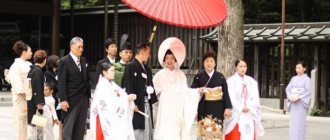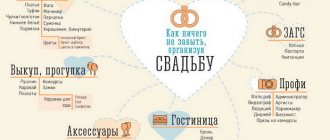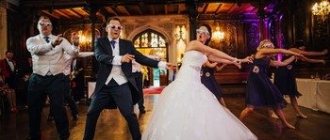Every culture has its own identity. This concept includes folklore, songs and dances. It is these indicators that characterize the nation itself. Armenian culture is no exception. Armenian wedding dances, which the Caucasian peoples are able to recreate, amaze with their grandeur and beauty.
Initially, the dances of the Armenians, like those of any other nationality, were a manifestation of the pagan spirit. Subsequently, they began to reflect the inner world of the people themselves, having absorbed centuries-old traditions. Traditional Armenian folk dance was known in ancient times and today it does not lose fans.
Types of Armenian wedding dances
If you want to create the feeling of a national ceremony at your own wedding, then you must include several sensual moments. This is exactly what dance can become. Thanks to professional artists, the atmosphere of your chosen nationality will be created in the hall. Absolutely everyone present will be able to feel the character of the Armenian people.
There are several types of dances that are actively used for wedding banquets:
- Yarkhushta is a dance in which two men participate. Both depict an attack with sabers. One attacks first, and the second defends. Then the performers change roles. The movements during the performance are extremely sharp, the nerves are tense. This is a truly amazing dance. He, perhaps, like no other, is capable of reflecting the character of a nation. He has a steely character, willpower and fortitude.
- Kochari is one of the most common dance numbers. It is performed by a large number of people. If the guests at the celebration are at least a little familiar with the life of Armenians or even belong to this culture, then they can perform a similar number. Everyone present stands in a circle, puts their hand on their partner’s shoulder and begins their movement. At the same time, both women and men find themselves in the circle. The female half often takes handkerchiefs with them, waving them beautifully during the dance itself.
- Lorca – this is the number most often performed at weddings. This is due to its pagan roots. Previously, it was believed that this dance could bring wealth, prosperity and happiness to the family. All participants stand in one line and take each other’s little finger. In this image, you need to move forward, making dance movements.
- Ververi - thanks to such a number you can create a comic atmosphere at your own celebration. The artists stand in a line and join hands. During the dance, performers run forward and jump up. Thus, artists seem to attract good luck sent from heaven. It is noteworthy that the number itself consists of two parts. During the first, slow music plays, the tempo of the second accelerates. As a result, the dancers reach a logical conclusion by the end of their performance.
This is interesting: Karaoke wedding is a great idea for an unforgettable holiday
Wedding preparations
The traditions and customs of the Armenian people require a number of mandatory events to be held before celebrating a wedding.
The first obligatory ritual is the bride's viewing.
It is held with the purpose that the newlyweds have the opportunity to see each other before the wedding. To do this, the future groom and his close relative make a visit to the bride’s house, while treating the girl’s mother or sisters to sweets. Every other day, sweets are distributed to neighboring children.
To ensure that the celebration takes place in an organized manner, a ritual called “kyasum trel” is performed. During it, the groom and the groom's father negotiate all the expenses for the holiday, the number of people, the menu, etc. Next comes the stage of active preparation, which includes, first of all, an agreement on the date of the wedding in the church.
Issues regarding the number of guests are also discussed. The venue for the celebration is selected and the wedding program is drawn up.
How to choose music for Armenian dance?
It is necessary to decide not only on the number itself, but also on the musical background. It is impossible to imagine any beautiful performance without melodies. The ideal option would be if you manage to hire professional musicians.
Since all Armenian wedding dances have their roots in ancient times, the music itself must be from the same generation. Instrumental melodies can support the given atmosphere.
If you decide to go with this option, then the best way for you would be to discuss the musical background with the performers. They will tell you what music to perform this or that dance to. If you decide to choose only a soundtrack, then you will have to think in advance about which minus to download.
Be sure to test your minus at home and listen to what sound will come out. There are a large number of songs on the Internet that are called one way, but in fact represent a different melody.
To prevent this from happening to you, listen to the musical composition and make sure that what you see is exactly what you were looking for.
Engagement
Betrothal is almost the same large-scale event as the magnificent Armenian weddings themselves, so they take its preparation seriously. An important role is played by the planted father - Kavor, who will later become the godfather of the children of the bride and groom. To begin with, all the guests gather at the house of the Armenian groom’s family - usually many relatives and friends are invited. There, those present try several dishes, after which, with gifts and treats piled on large trays, they go to the house of their betrothed.
Before the threshold, the father of the future husband and head of the new family gives him a ring, chain, bracelet or other jewelry called nshan (Armenian engagement gift). The wife of the Kavor takes the bride out, after which the groom gives her the nshan. When the solemn Armenian custom has been carried out, the newlyweds and their guests enter the house: a magnificent feast awaits them there, where a variety of dishes and drinks are served, and after that everyone dances, has fun, and holds competitions. At the end of the fun and feast, the Kavor and the father of the future spouse agree on the wedding day.
TOP 10 best melodies
Armenian melody can be varied. Both traditional folk songs and modern sounds are welcome.
Important! If you are performing a traditional folk dance, then the best option for it would be a song from the same category.
If you have a slightly improvised dance in a modern style with inserts of a folk performance, then you can opt for this kind of musical compositions.
- Shalaho.
- Kochari.
- Timur Temirov - Armenian wedding.
- Rhythms of the Caucasus - Armenian Shalokho.
- Wedding Vagzali.
- Dj Suro – Armenian Wedding.
- Lernapar.
- K. Orbelyan - Armenian song.
- Lezginka.
- Timur Temirov - Just me.
This is interesting: We stage a beautiful and touching first dance of the newlyweds at a wedding
Armenian wedding, bride's dance.
Don't forget about the classic lezginka. It is certainly not considered only an Armenian dance. However, all the nationalities of the Caucasus perform a similar number. And each nationality does it in its own way. Lezginka at a wedding banquet is the best option to perform, as it always looks fiery and bright.
Choosing the right musical composition is already half the success. After all, the performers will need to get into the rhythm and clearly hear the beat and understand the movements. Music is everything for dance. This is why professional artists spend so much time and carefully choosing the appropriate composition.
Funeral
Armenians are very sensitive to the dead and burial rites. Folk culture has preserved many ancient signs that are still practiced today. They believe that a person's destiny is written on the forehead. If you look closely, you can see the date of death. Long agony symbolizes the reluctance of the spirit to part with the earthly body, about unfinished business that requires its intervention. Armenian traditions and customs prescribe in such cases to help the dying person. The windows are thrown wide open, the pillow is removed, and favorite sweets, household items, and photographs are laid out nearby. The ritual makes it possible to remember one’s existence on earth, say goodbye to all relatives and calmly depart to another world without suffering.
Regarding death, Armenians believe in evil spirits that need to be driven away. When death comes to the house, all mirrors are curtained, clocks, wall clocks, hand clocks are stopped, housework is not allowed, and candles are lit in the deceased’s room.
They are sent on their final journey according to Christian canons. They invite a priest and wash the body. A coffin lid is placed outside the house to announce the sad news and to ask those around them not to make noise or have fun.
The funeral is scheduled on the third day after death. A piece of prosphora and a cross are placed in the hands and wrapped in a shroud. Relatives, friends, and acquaintances gather for the funeral to pay their last respects. A special box is placed in the house to collect money and everyone who wishes leaves whatever financial assistance they can. Stealing money on this day is a mortal sin. If the deceased has unfinished business with someone, then the other party should tell the family about it and try to repay the debt or ask for its fulfillment.
Armenian traditions require that before carrying out the coffin, you hit the lid three times, asking to let the soul into heavenly paradise. Women do not go to the cemetery, but prepare a funeral dinner. You can put a pack of cigarettes, your favorite pipe, or glasses in the coffin. The priest performs the ritual and the deceased is lowered into a hole and covered with earth.
The funeral table is prepared from national dishes of lamb and beef. Khashlama, kurkut, and vegetables are served. Relatives must gather on the 3rd, 7th, 40th day after death. They commemorate it on anniversaries, remember it at holidays and weddings.
Yandex pictures
Bottom line
Armenian dances at weddings are always accompanied by folk clothing. In it, the performance of the number will look especially bright and impressive. If the bride or groom belongs to this culture, then they should definitely introduce it to the guests. The Armenian wedding dance will help with this in the best possible way.
After all, movements bring people together. And such a spectacular number at a wedding banquet will make everyone gasp with delight. Dancers are able to leave behind a magical impression and the spirit of an entire nation. With the help of simple movements, guests and newlyweds will experience the culture of an entire people.
The man is the head of the family
The Armenian family is built on the principle of male leadership. He makes important decisions regarding his wife and children, ensures prosperity in the house, invites guests, preserves cultural heritage and Christian customs. A patriarchal society with centuries-old traditions is built on respect for elders, wives, mothers, belief in the sanctity of marriage, and devotion to national traditions. The principles of mutual assistance, helping friends and relatives remain. Children are brought up strictly, according to church canons.
Yandex pictures
This is a nation of purposeful, energetic, dedicated people. Capable of fighting for their dignity and well-being. They are characterized by a quick temper, so you should talk to them carefully, they do not like to obey, they are good artisans, hardworking.
In the family, no one argues with the husband’s authority. The woman takes care of the housework and devotes herself to raising children.
Kochari
Kochari is a very famous dance in Armenia. Each region of Armenia dances Kochari with its own individual style (different movements and music). The word Kochari means "knee, come" (koh-knee, ari-come). John Blacking in one of his books mentioned: “a group dance where dancers imitate jumping goats is known as Kochari. The dancers stand in a line, holding hands, and the tempo of the dance varies from moderate to fast. Squats and butting an imaginary opponent are accompanied by high jumps.”
The symbolic meaning of the ritual in the customs of the ancient Slavs
Symbolic meaning
Since ancient times, among the Eastern Slavs, a young unmarried girl wore her hair braided, decorated with a wreath of flowers and herbs. The wreath was both a decoration and a kind of hair clip; it was woven into a braid. When a girl got married, her braid was unraveled and the wreath was taken out of her hair. From that moment on, a woman had no right to go bare-haired in front of strangers; a headdress was put on her head; each nation had its own.
Over time, wreaths were replaced by veils, which came into fashion and culture of the Slavs from Western peoples. The customs gradually transformed, but the order of the ritual has been preserved to this day. Its meaning also remained the same: farewell to a free unmarried life, and the transition to a new status - the status of a wife (that is, covering the head with a scarf). The mother-in-law put a scarf on the head of the newly-made wife, which was the personification of the daughter-in-law’s submission to her new relative, recognition of her power.
The tradition of confirming the virginity of the future wife
In traditional patriarchal Armenian families, the ritual of confirming the innocence of the future wife remains and is observed. After the first wedding night, a messenger is sent to the home of the honest and responsible bride with a red apple praising her parents.
The bride was always given a dowry of money and household necessities. The size of the dowry was traditionally discussed in half-joking conversations during matchmaking and betrothal. The groom's parents may refuse that they do not need any dowry, as long as the Armenian wedding takes place. As in many nations, weddings are celebrated in the fall after the harvest or at the beginning of winter, at this time the bins are filled and young wines are ripening. The benefits of autumn weddings were confirmed by ancient treatises on medicine written in Armenian; the body is saturated with vital forces at this time.
Toasts in Georgian
It is in the native Georgian language that toasts sound with particular melody and beauty. If you are present at a celebration and don’t even understand what is being said, then in any case the congratulatory speeches will touch you, since they sound with special tunes and words.
- მაღალ მთებში ცხოვრობდა ლამაზი ყვავილი, მისი ს ილამაზის გაგიჟდა ყველა გარშემო. მისი სუნი იყო მიმზიდველი, ბევრი მოგზაურებს ავ ლით და გვიყვარს ისარგებლოს ვნებიანი სუნი. მაგრამ ყვავილი არასოდეს აუღია მხოლოდ სიამოვნ ებს სილამაზე გავლის მოგზაურთათვის. მოდით, ამაღლება ჩვენი სათვალე უნდა ჩვენი პატა რძალი, რომ ძალიან ყვავილების, რომ ჩვენი groom მიიღო. დაე, შეინახოს იგი და უსაფრთხო.
- შორს მთებში ცხოვრობდა მწყემსი, რომელიც შემიყვ არდა ლამაზი ქალიშვილი მდიდარი კაცი. off ი. რამდენიმე დღის შემდეგ, ქალიშვილი იქორწინა მეგ ობარი მისი მამა. ამ ზეიმი იყო მწყემსი და სთხოვა, გადადება, ხვალ ქორწილი. Groom ღეს იგი ბლუმი, ტომი და groom ლამაზი პატარძალი. დილით მწყემსი გაჩნდა აყვავებული ჯოხი. მოდით, ამაღლება ჩვენი სათვალე უნდა ძალა სიყვა რულისა, რომელიც შეიძლება არაფერი.
3. ოჯახის ცხოვრება მშფოთვარე ზღვაში. ზოგჯერ ეს არის მშვიდი და მშვიდობიანი, ლამაზი შ ევხედოთ მას და სურს ისარგებლოს დღე. და ზოგჯერ ზღვის გააფთრდა, მაშინ მე მინდა, რომ ს წრაფად დამშვიდება და დაისვენოთ. მოდით დაქორწინებული წყვილი, ოჯახის ცხოვრება ი ქნება სხვადასხვა, მაგრამ ყოველთვის ბედნიერი.
Lace tulle Nellie
The longer the veil, the longer the happy family life. This generally accepted concept can confuse many brides, since most of them do not realize that the history of the appearance of a long veil is quite simple and has nothing to do with this statement.
According to legend, a certain Nellie Custis, who lived in the 18th century, stood near the window against the backdrop of lace tulle falling on her, and groom Lawrence Lewis could not stop admiring her ethereal beauty.
For this reason, the girl decided to wear a long veil, reminiscent of the tulle from the windows of her room, in order to please her future husband at the wedding ceremony.
The above-mentioned statement partially originates from Ancient Greece, when brides were dressed in yellow, light, toe-length linen.
Words before removing the veil in prose
“Mommy is the most beloved, dearest person on earth, she gave you life, she surrounded you with tenderness and care. And today my mother is giving her little blood away in marriage. Now mom will take off your veil. And this moment will divide your life in half. Your childhood and carefree youth will remain behind you. And ahead of you, like every girl, a woman’s fate awaits you. What it will become depends on the two of you. Let the groom be a kind, caring husband for his bride. And let the bride become a faithful, gentle and caring wife for her husband. Now the mother will approach her daughter, touch her with her kind, motherly hands and take off the wedding veil. In front of all the guests, we will tremblingly place the girl’s veil in a magic casket and lock it with a key. We will immediately give this casket to the groom.. You should not open the casket until that happy moment until your first-born is born. Only after the birth of the baby can you take out a wedding veil and throw it over your child’s crib. The wedding veil - having absorbed the happiness and joy of today - will protect your child from the evil eye.”
After these words, the mothers begin to remove the wedding veil.
How does the “rite of cutting the bride’s dress” take place?
This ritual has always accompanied ancient weddings, usually during the engagement day, but now it takes place a few days before the celebration or is not performed at all. On the day of cutting the bride's dress, the female relatives of the Armenian groom - mother, sisters, as well as the Kavor's wife, who bought a special cut for the wedding dress, come to visit her.
The essence of the ritual is that the Kavor’s wife begins to cut out an outfit for an Armenian girl, then abruptly stops, saying that the scissors are dull, cutting with them is a lot of work. The woman does not continue cutting until she is paid a ransom. After a small reward, she starts cutting again. After this, everyone present is treated to food.
Is a veil necessary?
Nowadays, many brides choose dresses without a veil, considering it an extra unnecessary detail that also hides festive makeup. The desire to create a luxurious hairstyle, the fear of not finding a model that matches the color and style - there are many reasons for refusing a veil.
The tradition of covering the bride’s face is not originally Slavic; it came to us from Europe, where people believed that the bride needed a veil to protect her from the evil eye of ill-wishers and envious people. And the burqa, which women of the East still wear, serves the same purpose - to hide beauty and youth from the eyes of strangers.
As for the veil, initially it was made completely opaque, but over the years, obstinate fashionable brides have won the right to a veil made of airy and light materials. And the girl hiding her face behind thin elegant lace looks mysterious and beautiful.











